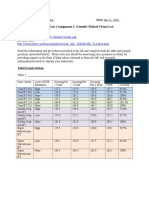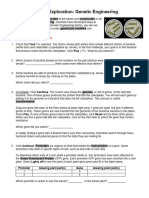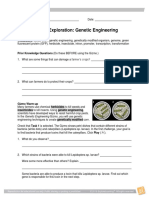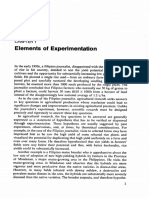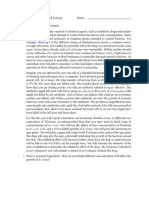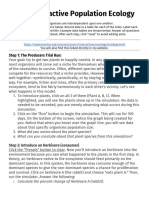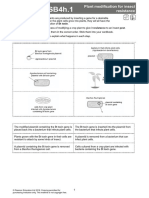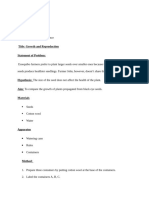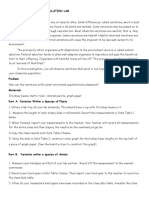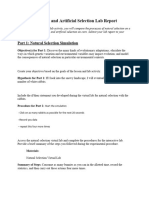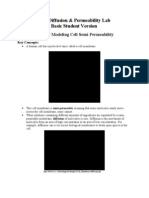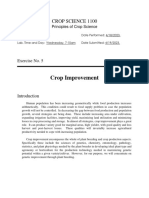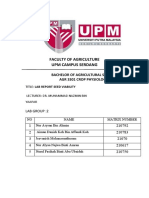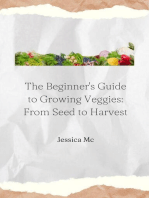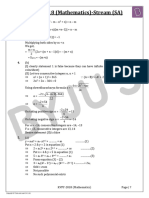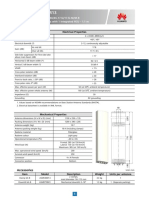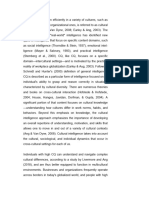Lab 1 Worksheet: Dependent and Independent Variables
Lab 1 Worksheet: Dependent and Independent Variables
Uploaded by
Keith JonesCopyright:
Available Formats
Lab 1 Worksheet: Dependent and Independent Variables
Lab 1 Worksheet: Dependent and Independent Variables
Uploaded by
Keith JonesOriginal Title
Copyright
Available Formats
Share this document
Did you find this document useful?
Is this content inappropriate?
Copyright:
Available Formats
Lab 1 Worksheet: Dependent and Independent Variables
Lab 1 Worksheet: Dependent and Independent Variables
Uploaded by
Keith JonesCopyright:
Available Formats
Lab 1 Worksheet: Dependent and Independent Variables
Student instructions: Follow the step-by-step instructions for this exercise found on the worksheet below and in the virtual lab and record your answers in the spaces below. Submit this completed document by the assignment due date found in the Syllabus. Please make sure that your answers are typed in RED. Please type your Name and Student ID Number here: Keith Jones / Student ID: 4173049 Directions 1. Open the virtual lab titled Dependent and Independent Variables. 2. The screen will display the virtual lab simulation on the right side, and a Questions column on the left side. 3. Read all information in the Greenhouse Handbook. To open the handbook, click on Greenhouse Handbook on the shelf above the growth chamber in the lab simulation. 4. Read all background information and instructions in the Questions column. 5. If you come upon terms that are unfamiliar to you, please refer to your textbook for further explanation or search the word here: http://encarta.msn.com/encnet/features/dictionary/dictionaryhome.aspx 6. Answer Lab Questions 1-5 below. 7. Follow the procedure below to complete the lab experiment. There are four seed varieties: two transgenic varietiesBT 123 and BT 456and two non-transgenic varietiesGolden Crop and Super Harvest. You must gather data for all four varieties at levels of no infestation, low infestation, and high infestation. You may need to reset the simulation several times to see and select each of the four varieties. Record all of your data in Tables 1 and 2 below. Procedure
1. Click and drag a seed variety chambers.
to each of the two growth
2. You may choose to plant one or two different types of corn. The seeds will be planted in all three pots and each growth chamber will automatically be labeled. Click on the reset button to choose from other varieties of corn.
3. Click and drag a level of ECB infestation the growth chambers.
to each set of plants in
4. You may choose to have no infestation, a low level of infestation,
or a
high level of infestation for each seed type. The selection will be applied to each plant in the growth chamber and the label will be updated with the information of the level of the ECB treatment. 5. Click on the Grow button. You will see an animation of the calendar indicating the number of days that have passed. At the end of the time period, the chamber doors open and the fully grown plants are evaluated. 6. Click and drag each ear on each of the plants to a separate weighing dish. The yield of kernels from each plant is now on a weighing dish. 7. Drag a weighing dish to the balance to read the weight of the kernels. Record the weight in Table 1 below. Proceed to weigh the kernel yield from each plant. 8. Calculate the average kernel yield from each set of three plants that were grown under identical experimental conditions from the same type of seed. Calculate the Average Yield for each seed variety at each level of infestation. To calculate the Average Yield for one seed variety at one level of infestation use the following formula: Average Yield = (Pot 1 yield + Pot 2 yield + Pot 3 yield)/3 *Round all average yields to the second (hundredth) decimal place. 9. Click the reset button to repeat the experiment by changing the variable of the ECB infestation level and/or seed variety. 10. When all data are recorded in Table 1, calculate the Percent (%) Reduction in Yield for each seed variety. To calculate the Percent (%) Reduction in Yield for one seed variety use the following formula: 2
Percent (%) Reduction in Yield = (avg. yield with no infest. avg. yield with high infest.)/avg. yield with no infest. X 100 *Round all Percent (%) Reduction in Yield values to the second (hundredth) decimal place. Record this data in Table 2 below. 11. Answer Lab Questions 6-12 below. Lab Questions 1. ECB refers to which of the following? a. A genetically engineered plant that is resistant to insect pests b. Edible corn byproducts c. An insect pest that reduces corn yield d. European corn borer e. Both c and d 2. How many days are required for a corn seed to become a mature plant with maximum weight kernels ready to be harvested? a. About 23 b. About 65 c. About 140 d. About 180 3. BT Corn refers to corn that: a. Has been infested with insect pests b. Has been infected with bacteria c. Is resistant to ECB d. Is not affected by pesticides 4. What is BT? a. A stomach poison produced by bacteria. b. A genetically engineered corn product. c. A bacterium carried by the European corn borer. d. A bacterium that has a gene for producing Cry proteins. 5. Creation of BT corn requires genetic material from all of the following except: a. European corn borer b. Bacillus thuringiensis c. a corn plant d. all of the above contribute genetic material to the production of BT corn Table 1: Average Yield (g) for each seed variety at no, low, and high infestation levels 3
Seed Variety BT 123
Level of ECB Infestation None Low High
Pot 1 Yield 160.1 164 155.1 190 178.8 157.3 181.6 177.9 135.4 164.1 159.1 125.5
Pot 2 Yield 164.8 162.6 163 183.2 172.6 157 182.8 171.2 139.6 164.3 155 129
Pot 3 Yield 164.2 168.3 163.9 184.8 179.6 159 189.8 170.6 138.3 161.9 157.5 130
Average Yield 163.03 164.97 160.67 186 177 157.77 184.73 173.23 137.77 163.43 157.20 128.17
BT 456
None Low High
Golden
None Low High
Super Harvest
None Low High
Table 2: % Reduction in yield for each seed variety at high levels of infestation (Transfer data on Average Yield (g) with No Infestation and High Infestation from Table 1 to Table 2) Seed Variety BT 123 BT 456 Golden Super Harvest Avg. Yield with No Infestation 163.03 186 184.73 163.43 Avg. Yield with High Infestation 160.67 157.77 137.77 128.17 % Reduction in Yield 1.45 15.18 25.42 21.57
6. For each seed variety, why did you need to collect data from 3 pots for each infestation level to obtain reliable data? In order to get an average number a larger number of pots needed to be collected 7. Which seed variety has the highest yield under conditions of no infestation? BT 456
8. Which transgenic seed variety was most resistant to the ECB at high infestation levels? BT 123 9. Which non-transgenic seed variety was most resistant to the ECB at high infestation levels? Super Harvest 10. Compare the yield of Super Harvest seeds and BT 123 seeds under conditions of no infestation. Is there any significant difference in the average yield? No significant difference 11. If you compared one pot of Super Harvest and one pot of BT 123 with no infestation, would you expect the yield of each pot to be within 0.5g of the other? Explain your answer. No, the overall results were based on an average of three pots per seed. 12. A farmer decides to plant 90% of one field with BT 123 seeds and the remaining 10% of the field with a different seed variety. He hopes this will slow the evolutionary development of BT resistant insects. Which seed variety should he use to plant the 10% of his field that is not planted with BT 123 seeds? Explain your answer. Golden seed variety should be used because the average yield is higher than the Super Harvest variety
You might also like
- Genetic Engineering Gizmo Student Exploration SheetDocument7 pagesGenetic Engineering Gizmo Student Exploration SheetCarter Bones50% (8)
- Seed Germination Report Sample (Easy)Document7 pagesSeed Germination Report Sample (Easy)VanAra71% (7)
- HORT 22 Lab Exercise No. 2a: Sexual Propagation of Horticultural CropsDocument4 pagesHORT 22 Lab Exercise No. 2a: Sexual Propagation of Horticultural CropsRenier OronosNo ratings yet
- Student Exploration: Genetic EngineeringDocument7 pagesStudent Exploration: Genetic Engineeringcokcre100% (3)
- Biotechnology Lab Report-2Document12 pagesBiotechnology Lab Report-2Rachel Coley100% (1)
- Biology 12 Unit 1 Assign't 2 Scientific Method Virtual Lab-2Document6 pagesBiology 12 Unit 1 Assign't 2 Scientific Method Virtual Lab-2paulclarkenorthvan100% (1)
- Biology 12 Unit 1 Assignment 2 Scientific Method Virtual Lab 2Document6 pagesBiology 12 Unit 1 Assignment 2 Scientific Method Virtual Lab 2paulclarkenorthvanNo ratings yet
- Biology 12 Unit 1 Assignment 2 Scientific Method Virtual LabDocument5 pagesBiology 12 Unit 1 Assignment 2 Scientific Method Virtual Labapi-291218692No ratings yet
- Biology 12 Unit 1 Assignment 2 Scientific Method Virtual LabDocument3 pagesBiology 12 Unit 1 Assignment 2 Scientific Method Virtual Labapi-338578874No ratings yet
- Biology 12 Unit 1 Assignment 2 Scientific Method Virtual Lab-2Document6 pagesBiology 12 Unit 1 Assignment 2 Scientific Method Virtual Lab-2api-347060961No ratings yet
- Genetic Engineering SEDocument7 pagesGenetic Engineering SEgarrettzyah6No ratings yet
- GeneticEngineering GizmoDocument4 pagesGeneticEngineering GizmokallenbachcarterNo ratings yet
- GeneticEngineeringSE PDFDocument7 pagesGeneticEngineeringSE PDFBethanie BantigueNo ratings yet
- Laboratory #4 Assignment TemplateDocument8 pagesLaboratory #4 Assignment TemplateJohn Mar LumbayanNo ratings yet
- Week 1 Dependent and Independent Variables Lab SheetDocument2 pagesWeek 1 Dependent and Independent Variables Lab SheetMaria Wilkerson71% (7)
- Agriculture ScienceDocument23 pagesAgriculture SciencenickjaeguthrieNo ratings yet
- Biometry Chap 1 To 4 For Biotech2023Document46 pagesBiometry Chap 1 To 4 For Biotech2023Essays EsayasNo ratings yet
- 03b Bacterial resistanceDocument8 pages03b Bacterial resistancenyashaasherayaanNo ratings yet
- BCT Practice QuestionsDocument26 pagesBCT Practice Questionsphatlim919No ratings yet
- HL IB Biology II - Seed Germination LabDocument4 pagesHL IB Biology II - Seed Germination LabtyrekethomasNo ratings yet
- Vi nhựa trong nước mặtDocument11 pagesVi nhựa trong nước mặtVan Tran KhanhNo ratings yet
- Photosynthesis Virtual LabDocument5 pagesPhotosynthesis Virtual Labapi-238808066No ratings yet
- Student Exploration: Gmos and The EnvironmentDocument12 pagesStudent Exploration: Gmos and The EnvironmentSumaira UddinNo ratings yet
- Online Interactive Population EcologyDocument2 pagesOnline Interactive Population EcologyJanine BertolottiNo ratings yet
- 151 Ud55Document10 pages151 Ud55Van Tran KhanhNo ratings yet
- 2021 Lab 6 GeneticsDocument10 pages2021 Lab 6 GeneticsGurleen KaurNo ratings yet
- Detection of GMO Foods - Student ManualDocument25 pagesDetection of GMO Foods - Student ManualNkechiNo ratings yet
- tmp7038 TMPDocument4 pagestmp7038 TMPFrontiersNo ratings yet
- Quarter 1 - Module 4 Characteristics of Good Quality SeedsDocument19 pagesQuarter 1 - Module 4 Characteristics of Good Quality SeedsioNo ratings yet
- Bacteria Resistance To Antibiotics Science Fair ProjectDocument3 pagesBacteria Resistance To Antibiotics Science Fair ProjectZaina ImamNo ratings yet
- Cell Diffusion & Permeability - Advanced VersionDocument8 pagesCell Diffusion & Permeability - Advanced VersionTeachLABScINo ratings yet
- SB4h WorksheetsDocument7 pagesSB4h WorksheetsyourseriousdevNo ratings yet
- 11236 黃品璁Robin - Grade 10 - Rise Up LabDocument4 pages11236 黃品璁Robin - Grade 10 - Rise Up Labrobinhuang3233No ratings yet
- intelabs (1)Document4 pagesintelabs (1)lianakissoonNo ratings yet
- DocumentDocument14 pagesDocumentEdrian FloresNo ratings yet
- BI206 Week1 Lab ResponsesDocument4 pagesBI206 Week1 Lab ResponsesJaelen KnollaNo ratings yet
- Growing Bean ActivityDocument7 pagesGrowing Bean ActivitySimoneNo ratings yet
- Variations Within A Population LabDocument4 pagesVariations Within A Population LabchristineNo ratings yet
- CW - 4.1.2.a ProteinfactoriesDocument7 pagesCW - 4.1.2.a ProteinfactoriesPurePureMilkNo ratings yet
- GMOSEnvironmentSEDocument7 pagesGMOSEnvironmentSEnotfoundnayaNo ratings yet
- 07 02 Natural and Artificial Selection Lab ReportDocument7 pages07 02 Natural and Artificial Selection Lab Reportsaif.elsharaawyNo ratings yet
- AFA Animal Production9 Quarter1 Module 8Document19 pagesAFA Animal Production9 Quarter1 Module 8Ramil F. AdubalNo ratings yet
- Integrated Pest Management (IPM) Sweet Corn Planning ProjectDocument13 pagesIntegrated Pest Management (IPM) Sweet Corn Planning ProjectCatherine Hazel AguilarNo ratings yet
- Exer. 6Document7 pagesExer. 6johnrenzcuadranteNo ratings yet
- Lab 7: Experimental Evolution (Artificial Selection, Continued) & Biological Diversity (Part I)Document2 pagesLab 7: Experimental Evolution (Artificial Selection, Continued) & Biological Diversity (Part I)Owen WalkerNo ratings yet
- Cell Diffusion & Permeability - Basic VersionDocument9 pagesCell Diffusion & Permeability - Basic VersionTeachLABScINo ratings yet
- Bacterial CountsDocument5 pagesBacterial CountsAndrew LeeNo ratings yet
- TLE - ANIMAL - Module 4 - v5Document15 pagesTLE - ANIMAL - Module 4 - v5Shen ShineNo ratings yet
- Seed GerminationDocument8 pagesSeed GerminationDM RielNo ratings yet
- 9-Food and WaterTHE MICROBIOLOGICAL EXAMINATION OF FOODS & WATERDocument16 pages9-Food and WaterTHE MICROBIOLOGICAL EXAMINATION OF FOODS & WATERArri KurniawanNo ratings yet
- 11 Bacterial NumbersDocument7 pages11 Bacterial Numbersrohitmaurya2032002No ratings yet
- Crop-Selection-and-ManagementDocument59 pagesCrop-Selection-and-ManagementcmmabdiqaniNo ratings yet
- IBALEDocument8 pagesIBALEIbale, Arjay D.No ratings yet
- Group Manu - Seed ViabilityDocument10 pagesGroup Manu - Seed ViabilityAiman Danish KohNo ratings yet
- Cell Diffusion & Permeability - Teacher VersionDocument9 pagesCell Diffusion & Permeability - Teacher VersionTeachLABScINo ratings yet
- Growing Plants (Following The Honors Bio Lab Report Sections)Document6 pagesGrowing Plants (Following The Honors Bio Lab Report Sections)David YeeNo ratings yet
- Plant Breeding 101: How to Win In the Commercial Seed BusinessFrom EverandPlant Breeding 101: How to Win In the Commercial Seed BusinessRating: 5 out of 5 stars5/5 (1)
- Vegetable Gardening 101: 20 Vegetables You Can Grow Easily in Your Organic GardenFrom EverandVegetable Gardening 101: 20 Vegetables You Can Grow Easily in Your Organic GardenNo ratings yet
- $$ Kiln Comprehensive EnglishDocument119 pages$$ Kiln Comprehensive EnglishMohammed BNo ratings yet
- KVPY SA 2018 Maths Question Answerkey SolutionsDocument1 pageKVPY SA 2018 Maths Question Answerkey SolutionsSaloni KumariNo ratings yet
- Business and Society 1Document31 pagesBusiness and Society 1Arnin OwonNo ratings yet
- ANT-ADU4518R13-2405 DatasheetDocument2 pagesANT-ADU4518R13-2405 DatasheetMuhammad KashifNo ratings yet
- Terminale 8200 - VectorDocument1 pageTerminale 8200 - VectorVasile TipcuNo ratings yet
- Maestro Servo Motor Gate Dz-01: Technical Parameter ListDocument2 pagesMaestro Servo Motor Gate Dz-01: Technical Parameter ListIlya PamuntjakNo ratings yet
- Hum1 ReviewerDocument3 pagesHum1 ReviewerPrincess Joy LucasNo ratings yet
- PracticeSheet P1earthsinteriorandearthquake-GoogleDocs 1708415109181Document7 pagesPracticeSheet P1earthsinteriorandearthquake-GoogleDocs 1708415109181respect3000pNo ratings yet
- SummaryDocument34 pagesSummaryMichelle GuoNo ratings yet
- 1.7. Interface en JavaDocument52 pages1.7. Interface en JavacybernytroNo ratings yet
- BK91-1310-CPF-999-PIP-DPS-0001 - 0 - Pipe Support Specification and Drawings - C1Document81 pagesBK91-1310-CPF-999-PIP-DPS-0001 - 0 - Pipe Support Specification and Drawings - C1Panneer SelvamNo ratings yet
- Check Out This File: Engg Physics MCQs - Unit 1 - PolarizationDocument10 pagesCheck Out This File: Engg Physics MCQs - Unit 1 - PolarizationNikhil SatbhaiNo ratings yet
- Question BankDocument15 pagesQuestion Bankdump mailNo ratings yet
- Sons of Ether RevisedDocument108 pagesSons of Ether RevisedAPCommentator100% (3)
- Zoe Equally Watered 2022Document4 pagesZoe Equally Watered 2022api-644774533No ratings yet
- Valves and Fittings: Continuing EducationDocument308 pagesValves and Fittings: Continuing EducationAbdul Basit Siddiqui100% (1)
- Scientific American Psychology 2nd Edition Licht Test BankDocument66 pagesScientific American Psychology 2nd Edition Licht Test Bankbob joeNo ratings yet
- Angular 6 Cli Cheat SheetDocument2 pagesAngular 6 Cli Cheat SheetIoritz UrrestarazuNo ratings yet
- Tunasan Environmental AssessmentDocument292 pagesTunasan Environmental AssessmentJeng AndradeNo ratings yet
- Ill Defined Property RightsDocument15 pagesIll Defined Property RightsAMRUTH ANAND 1750408No ratings yet
- Program ScheduleDocument123 pagesProgram ScheduledumpdpkprmNo ratings yet
- Class 12 Term 2 SET A Answer Key FinalDocument14 pagesClass 12 Term 2 SET A Answer Key FinalmoiiifitbituserNo ratings yet
- Hanan Ahmad - h00271779 - Lesson Plan 3Document3 pagesHanan Ahmad - h00271779 - Lesson Plan 3api-301077191No ratings yet
- Spe 143081 MSDocument22 pagesSpe 143081 MSkumar abhishek singhNo ratings yet
- Pins 10 10 10 10 10000Document4 pagesPins 10 10 10 10 10000brdyy1018No ratings yet
- GT Report NgiaDocument930 pagesGT Report NgiaAli HusnainNo ratings yet
- 6.R.The Little Ice AgeDocument3 pages6.R.The Little Ice Agems.pannupyonehlaingNo ratings yet
- CQ ESSAY (AutoRecovered) Redesigned 2Document12 pagesCQ ESSAY (AutoRecovered) Redesigned 2labibahmed706No ratings yet
- SPPH 581D Capstone Project Proposal Winter Term 2 2022: Objective StatementDocument3 pagesSPPH 581D Capstone Project Proposal Winter Term 2 2022: Objective StatementMitchell TrickettNo ratings yet
- Unit 2 - Lesson 2Document3 pagesUnit 2 - Lesson 2Crissa PilloratoNo ratings yet









